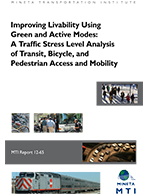- 408-924-7560
- mineta-institute@sjsu.edu
- Donate
Improving Livability Using Green and Active Modes: A Traffic Stress Level Analysis of Transit, Bicycle, and Pedestrian Access and Mobility
Understanding the relative attractiveness of alternatives to driving is vitally important toward lowering driving rates and, by extension, vehicle miles traveled (VMT), traffic congestion, greenhouse gas (GHG) emissions, etc. The relative effectiveness of automobile alternatives (i.e., buses, bicycling, and walking) depends on how well streets are designed to work for these respective modes in terms of safety, comfort and cost, which can sometimes pit their relative effectiveness against each other. In this report, the level of traffic stress (LTS) criteria previously developed by two of the authors was used to determine how the streets functioned for these auto alternative modes. The quality and extent of the transit service area was measured using a total travel time metric over the LTS network. The model developed in this study was applied to two transit routes in Oakland, California, and Denver, Colorado.
MAAZA MEKURIA, PhD, PE
Maaza Mekuria works as a transportation planner and engineer at the Hawaii Department of Transportation. He has done consulting and research work in transportation engineering since 1998. He has worked over 25 years in both the public and private sectors. Born and raised in the ancient land of Ethiopia, Axum City (home of the “Arc of the Covenant”), Dr. Mekuria did his undergraduate studies at Anna University, Chennai, India. He has an MSc. and PhD in civil engineering from Northeastern University, in Boston, Massachusetts. His research interests include transit modeling; big data modeling and analysis; GIS in transportation; traffic/transit simulation; network modeling and analysis; regional network metrics; and software and database design for transportation applications.
BRUCE APPLEYARD, PhD
Bruce Appleyard is an assistant professor of urban design and city planning at San Diego State University. He specializes in applied research of human settlement and behavior patterns at the intersection of urban design, transportation, land use, environmental science, and policy. His work focuses on how policies and practices can be used in concert with one another to improve a range of sustainability, livability, and social equity outcomes. Dr. Appleyard holds a BA, MCP, and PhD from the University of California, Berkeley.
HILARY NIXON, PhD
Hilary Nixon is professor of urban and regional planning at San José State University. Her research and teaching interests in environmental planning and policy focus on the relationship between environmental attitudes and behavior, particularly with respect to waste management and linkages between transportation and the environment. Dr. Nixon holds a BA from the University of Rochester in environmental management and a PhD in planning, policy, and design from the University of California, Irvine.
-
Contact Us
San José State University One Washington Square, San Jose, CA 95192 Phone: 408-924-7560 Email: mineta-institute@sjsu.edu






